MARIANI’S
July
17,
2010
NEWSLETTER
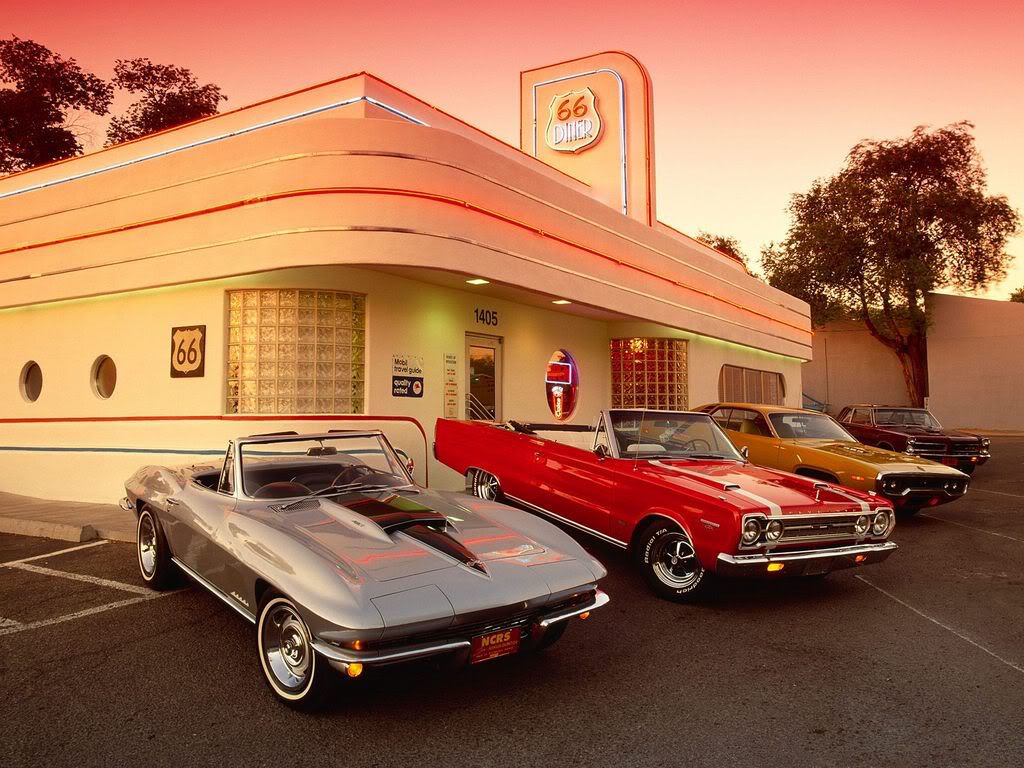
➔ QUESTIONS? TO REACH JOHN MARIANI
WRITE
TO: newsletter@johnmariani.com.
➔ ARCHIVE: Readers
may now access
an
Archive of all past newsletters--each annotated--dating back to July,
2003, by simply clicking on www.johnmariani.com/archive
➔ SUBSCRIBE AND
UN-SUBSCRIBE: You may subscribe anyone you wish
to this newsletter--free of charge--by
clicking here.
GOOD
NEWS! Esquire.com now
has
a
new
food
section
called
"Eat
Like
a
Man,"
which
will
be
featuring
restaurant
articles
by
John
Mariani
and
others
from
around
the
USA.
THIS WEEK: The
Michelin
Man
Goes
to
Chi-Town,
But Who Gets the Stars?
~~~~~~~~~~~~~
☛ In
This Issue
TRADITION and
INNOVATION IN THE BASQUE COUNTRY by Misha Mariani
NEW YORK CORNER:
Testaccio by John Mariani
MAN ABOUT TOWN by Christopher Mariani
QUICK BYTES
~~~~~~~~~~~~~
Tradition and Innovation
in
Basque Country Dining
by
Misha
Mariani
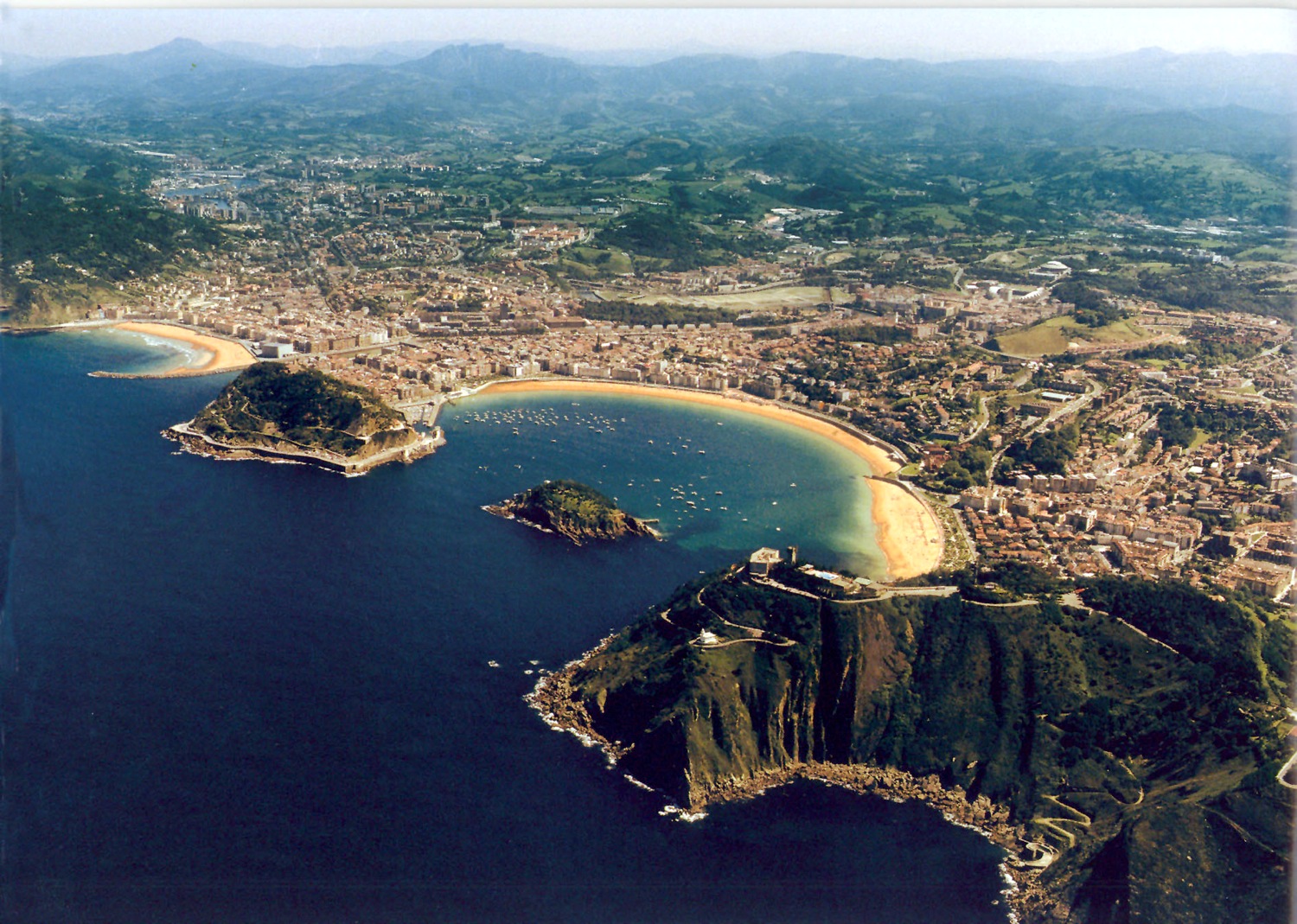
San Sebastián
As
a
whole,
Spain has a very strong national
identity and a community of people who want to hold onto their
regional
roots by calling on a history that pre-dates the Romans, but it is
quite evident that each region's people don't want to recognize
themselves as
Spaniards as much as they do Catalans, Valencians, Castillians, or,
especially,
Basques. In the Basque country of the north, the language is
drastically
different than Catalonian or any dialect, and during a recent trip I
noticed these distinctions firsthand
while sitting in a pintxos
bar in San
Sebastián when a woman tourist watching
a
TV
soccer
game
screamed
out,
“Viva España!” Not a
good
idea,
because
to
the
Basques,
España
is
little
more
than
a
generalization: the
locals
looked
at
her and started
yelling at her for what they took as profanity, as if she found the
regional patriotism insignificant.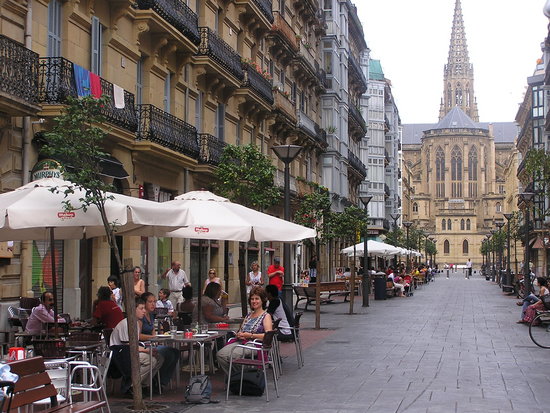
But besides the language, the Basque region is also defined by the glorious food and the social interactions that surround eating and drinking.
Most of our eating in town consisted of a lot of pintxos (the Basque term for tapas), which traditionally consists of slices of fresh bread topped with different items such as anchovies, peppers, jamon, and a few other ingredients. (To be wholly traditional about it, as Spanish food and wine authority Gerry Dawes points out, the topped breads are called montaditos, and pintxos are more on toothpicks, though pintxos are now being used interchangeably with tapas.)
Pintxos
bars tend to be the meeting places for friends, lovers, people on dates
,and are
the places where individuals come to socialize and relax over a glass
of beer
or txakoli, the fizzy regional white
wine poured from a height into the flat-bottom glass. Bouncing
from
one
bar
to
the next is very common, for
the reason that some bars are known for certain items and also because
a glass
of txakoli and pintxos will only
cost you €4-5, allowing you to move around as you
please.
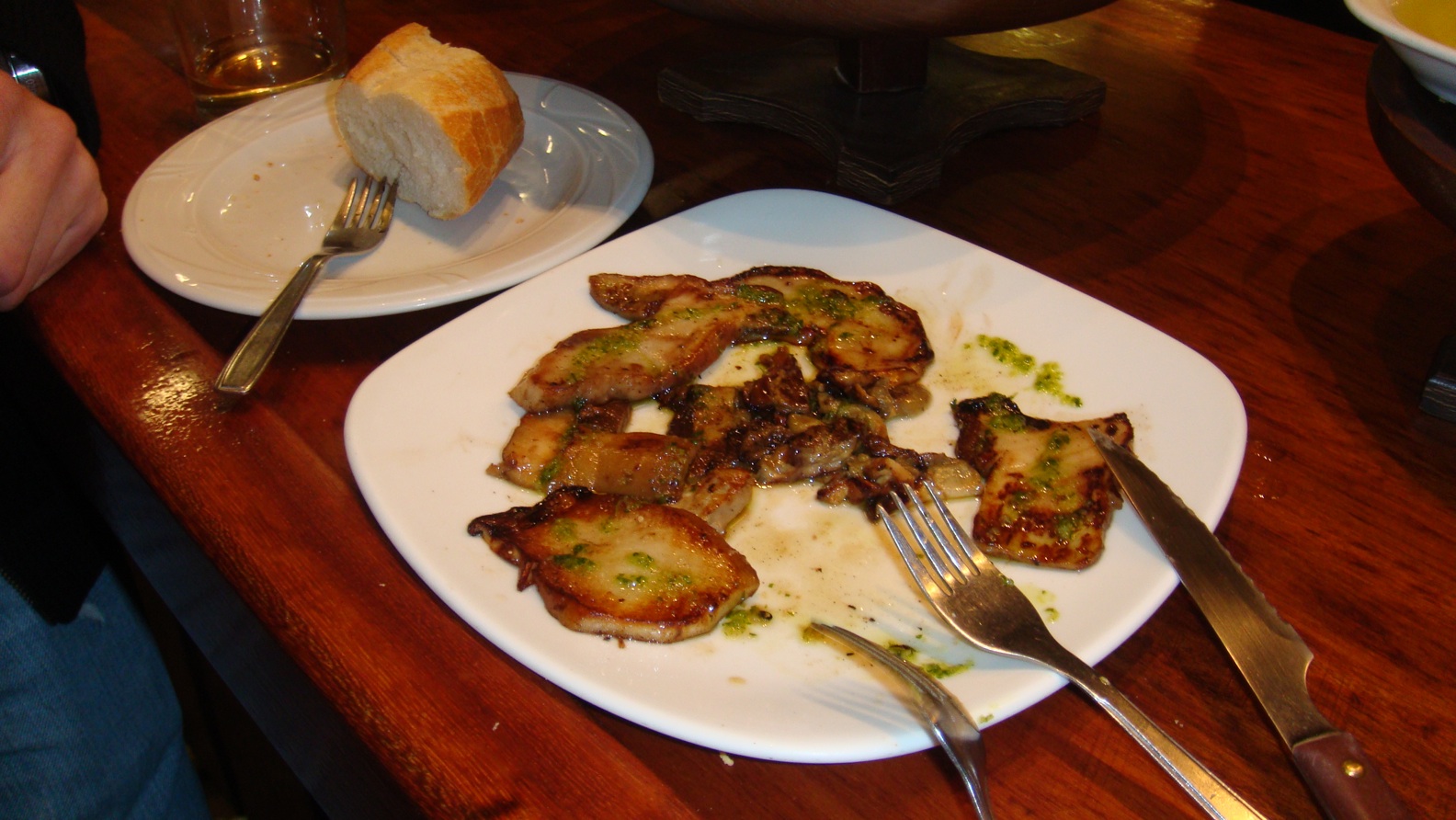 The
first bar we went to was Bar
Portaletas,
one of the larger in the area, where we had classic pintxos
of white anchovies, diced pimientos, and a pepper relish,
as well as with white anchovies, jamon
and an onion relish, both well
balanced,
clean tasting, with the right amount of fat, salt, and acidity.
The giant local
mushrooms called hongo beltza a la plancha (left) were
sliced and cooked on the griddle
and dressed with olive oil, parsley, garlic and sea salt.
The
first bar we went to was Bar
Portaletas,
one of the larger in the area, where we had classic pintxos
of white anchovies, diced pimientos, and a pepper relish,
as well as with white anchovies, jamon
and an onion relish, both well
balanced,
clean tasting, with the right amount of fat, salt, and acidity.
The giant local
mushrooms called hongo beltza a la plancha (left) were
sliced and cooked on the griddle
and dressed with olive oil, parsley, garlic and sea salt.
We
then
moved
on
to
Bar Ganbara, known
for their braised octopus, served either hot or warm with potatoes, a
generous
amount of olive oil, Spanish
paprika, and a side of fresh bread with which to sop up the oil.
Ganbara is also
recognized for its warm mini-croissant sandwiches (below) stuffed simply 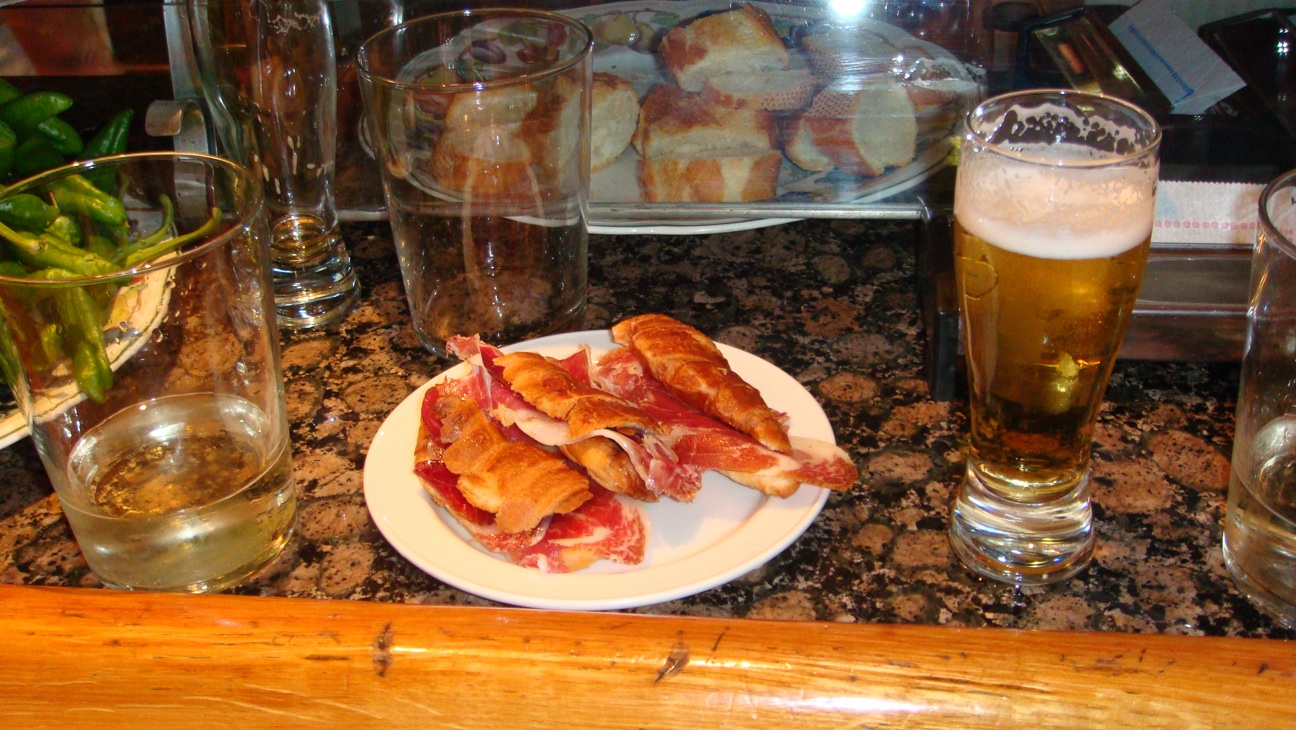 with great quality jamon
and melted cheese as well as
their croquetas de jamon, which
everyone does, but they do
perfectly.
with great quality jamon
and melted cheese as well as
their croquetas de jamon, which
everyone does, but they do
perfectly.
As
I
noted,
many
of
the
bars
are
known
for
specific
items:
La
Cepa, open since 1948, is the place to go for jamon
de
Jabugo. Here you can enjoy a
glass of txakoli and a small or
large palette of thinly sliced jamon
cut from one of the dozens of legs
that
hang from the ceiling. For anchovies, get over to Txepetxa,
which
cures
their
own
and
creates
exciting
and
delicious
pintxos with
them.
Not
all
the
bars
in
San
Sebastián
stick
to
classic
Basque
country
pintxos;
some
are
doing slightly more
modern, upscale dishes. For this type of bar, I recommend Cuchara De
San Telmo and Bar
Barri. At the former you can get small plates of braised beef
cheeks, cannelloni of braised meat trimmings with beef jus
and sea salt, croquetas of
sweetbreads (not that great), or
pig’s ear crisped on the plancha with
a puree of chickpea and braising jus.
And at Bar Barri, which I thought was a little better, you can sample
the goat’s
cheese à la plancha with sesame seeds
and prune puree; ham neck with pimiento
choricero, a traditional pepper puree; a tempura-fried croqueta of
mixed
meat
mousse and an aïoli; or stuffed piquillo peppers with beef cheek,
goat’s cheese, mushroom puree and
aïoli--all
extremely tasty and satisfying.
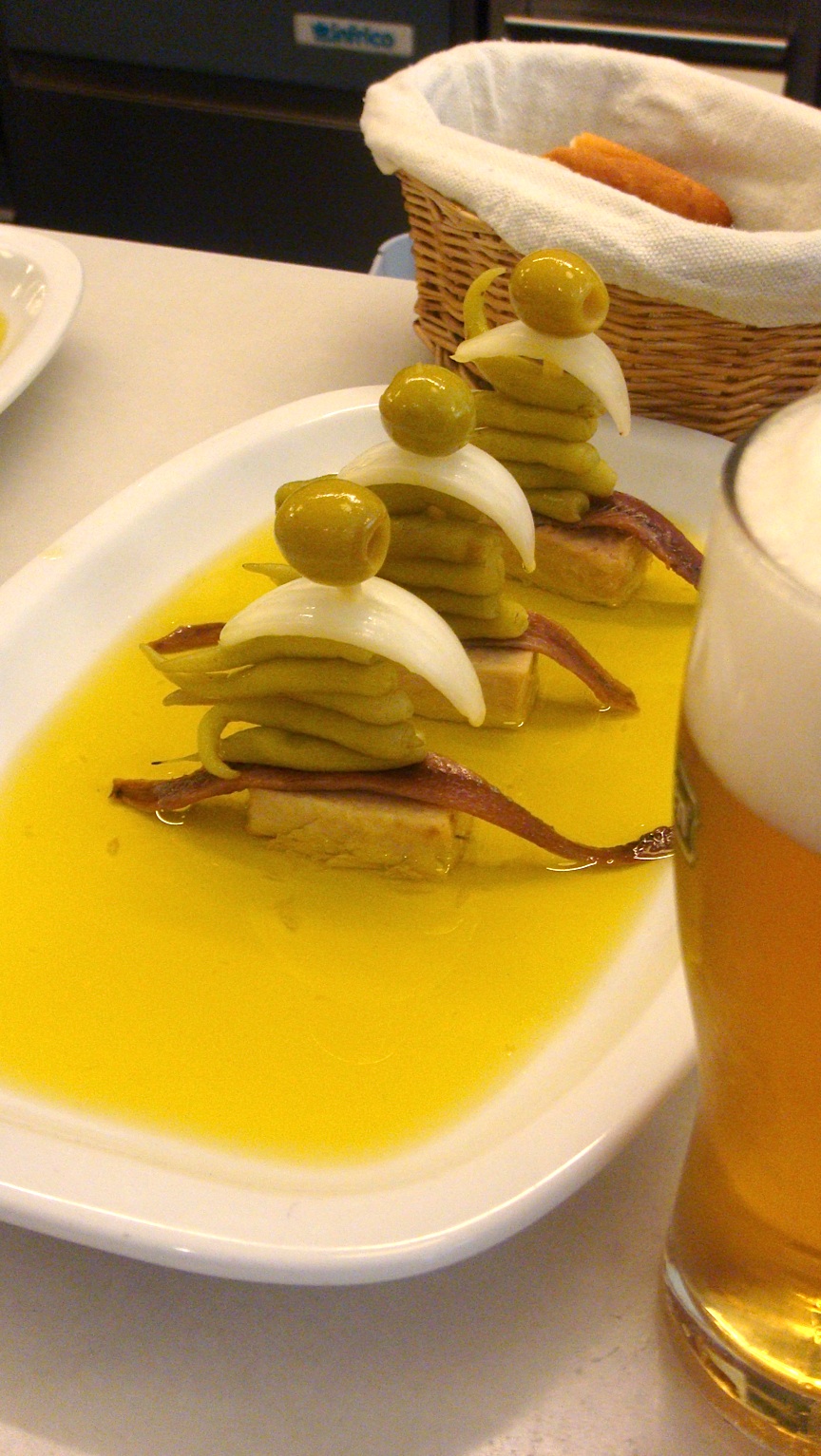 On
our last day in San Sebastián, our friends
brought us to one of their favorite places, Donostiarra,
quickly
becoming
one
of my favorites, a place with a long
history; once owned by a gentleman who decided
to close up shop after decades of success, the
new
owner
re-opened,
calling
on
the
previous
owner
to
ask
for
all
his
recipes
so
that
it could continue to produce the same food that
its
costumers had come to love.
On
our last day in San Sebastián, our friends
brought us to one of their favorite places, Donostiarra,
quickly
becoming
one
of my favorites, a place with a long
history; once owned by a gentleman who decided
to close up shop after decades of success, the
new
owner
re-opened,
calling
on
the
previous
owner
to
ask
for
all
his
recipes
so
that
it could continue to produce the same food that
its
costumers had come to love.
The design
of the bar is simple but
contemporary. Recommended items are the classic potato
and egg salad with cured anchovies; a plate of oil-packed anchovies (left),
tuna,
olives, and guindillas de ibarra (pickled
small green peppers); bocadillos (sandwiches
about four to six inches long) with tuna and anchovies or chorizo,
and
the
classic
pintxos, the
tortilla egg omelet with potatoes
cooked in olive oil, which most pintxos
bars make large size and serve
a slice
of; at Donostiarra they make personal sized ones in six-inch pans.
If your
time is limited in San Sebastián
and can’t frequent all the pintxos
bars that the city has to offer,
then make
sure Donostiarra is on your list.
The dining scene throughout Spain
is
extremely
relaxed
and
casual.
That’s
not
to
say
that
strolling
the
streets
at
dusk or under the street lights of the night dressed well with a
beautiful
woman on your arm won’t create an
indelible memory I highly recommend, but
as far as dress codes and requirements go, there really aren’t
any. The normal dress for men is casual slacks or jeans with a nice
polo or
button down shirt in most establishments. But don’t think the food or
service
is going to match the lax attitude; quite the opposite. 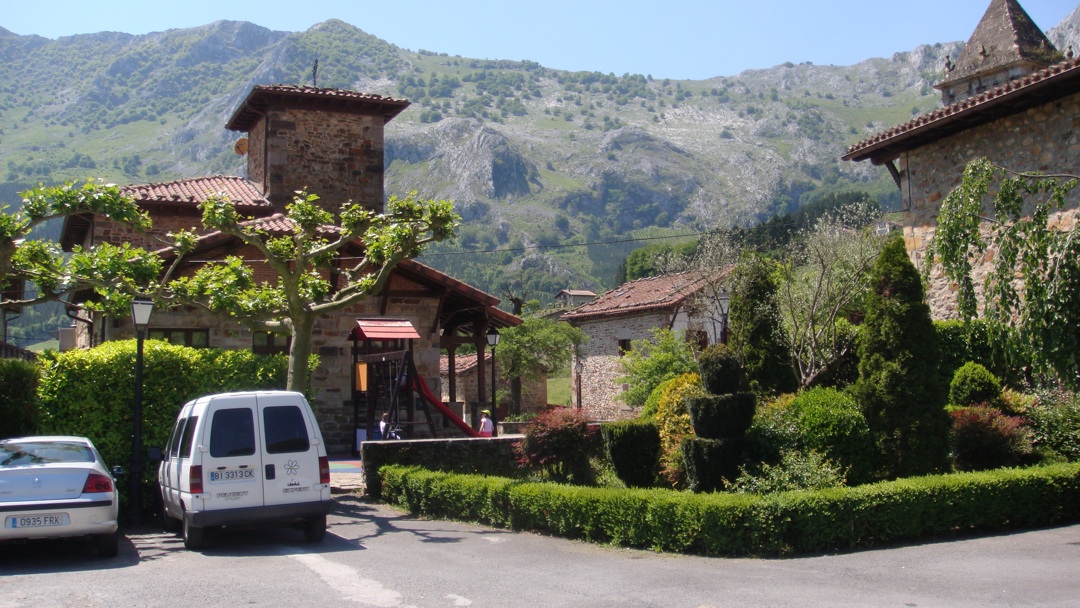 Here in the
Basque
country, the people pride themselves on their local ingredients,
traditional
dishes, attention to quality, and generous hospitality.
Here in the
Basque
country, the people pride themselves on their local ingredients,
traditional
dishes, attention to quality, and generous hospitality.
As
addictive
and
satisfying
as
pintxos bar
hopping can be, there are restaurants worth saving a little room and
euros for. Right
outside
of
San
Sebastián, about a 30-minute
drive, is an exceptional restaurant called Etxebarri. This
quaint
little
restaurant (right) in
the
tiny village of Axpe, with little else in it but the
lovely
Basque countryside as backdrop, rests in
a
building constructed in the 18th century and renovated in
1989
by
Victor Arguinzoniz, who is both the chef and owner. He took this
restaurant and
applied purity and focus on the highest quality
ingredients. But
he didn’t stop there. Many chefs claim to do the same thing, but I
don’t know any others
who build
numerous grills just so that each grill will house a specific type of
wood to
cook with. Every dish served at
Etxebarri is cooked on a wood-burning grill, including the desserts. It’s not just Arguinzoniz’s
attention to details, quality, and extreme talent that separate him
from
everyone else, it’s his adamant dedication to cooking in the oldest and
purest
way.
We
walked
into
the
restaurant
a
little
early,
so
we
decided
to
have
a
drink
at
the bar to buy some time. More txakoli!
A
young
woman
led
us
upstairs
to
the
dining
room,
asking
if
we preferred smoking or non-smoking, and showed us to our
table in a open room with
cathedral
ceilings, hanging 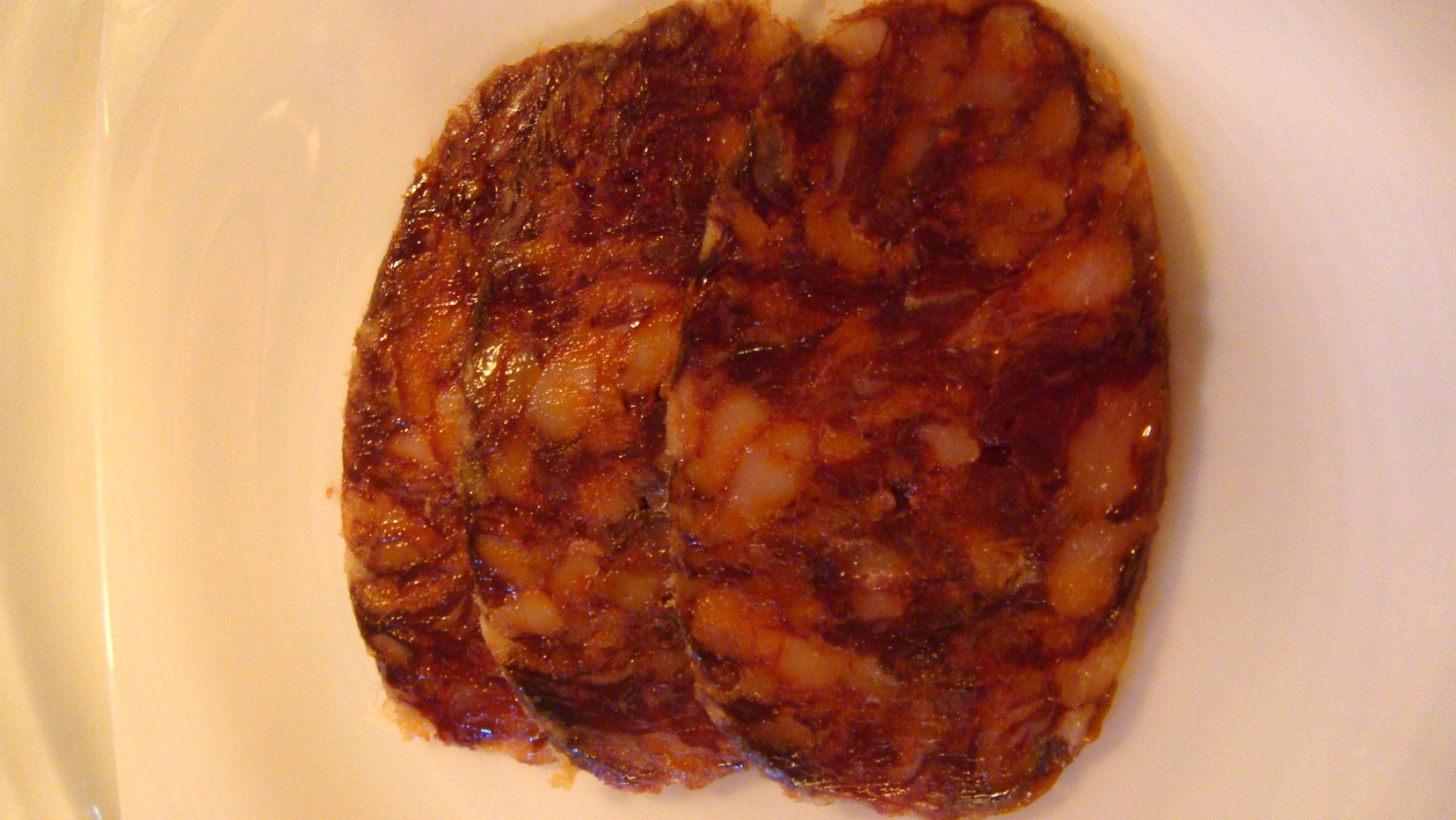 light fixtures of red glass, stone masonry,
and
barn house décor. The tables are simply set with white
tablecloths, fine
glassware, and beautiful silverware.
light fixtures of red glass, stone masonry,
and
barn house décor. The tables are simply set with white
tablecloths, fine
glassware, and beautiful silverware.
After
looking
at
the
menu
and
being
given
the
option
of
the
chef
cooking
for
us,
we all chose to have the tasting
menu. We
ordered a bottle of Itsas Mendi
Bizkaiko Txakolina No. 7, a
wine local to the region, with floral notes, well-balanced acidity, and
a
slight fruitiness.
At Etxebarri, the bread, baked in the
wood-burning ovens, is a good base on which to eat perhaps the finest chorizo (above)
I have ever had, made in
house, with a fat marbling that made it practically melt in your mouth
and a pork
flavor wholly unlike the lean fat free pork we have here in the States.
After
the chorizo, came a slice of country bread,
lightly toasted with smoked fresh goat’s butter, thinly shaved local
mushrooms
and raw baby vegetables, something you might find in New York at a locovore haven like Dan Barber’s
Blue Hill at Stone Barns.
At this point we moved on expectantly to
seafood, given the Basque country’s emphasis on the sea. Now, with our
appetites
just getting going, out came red prawns (below)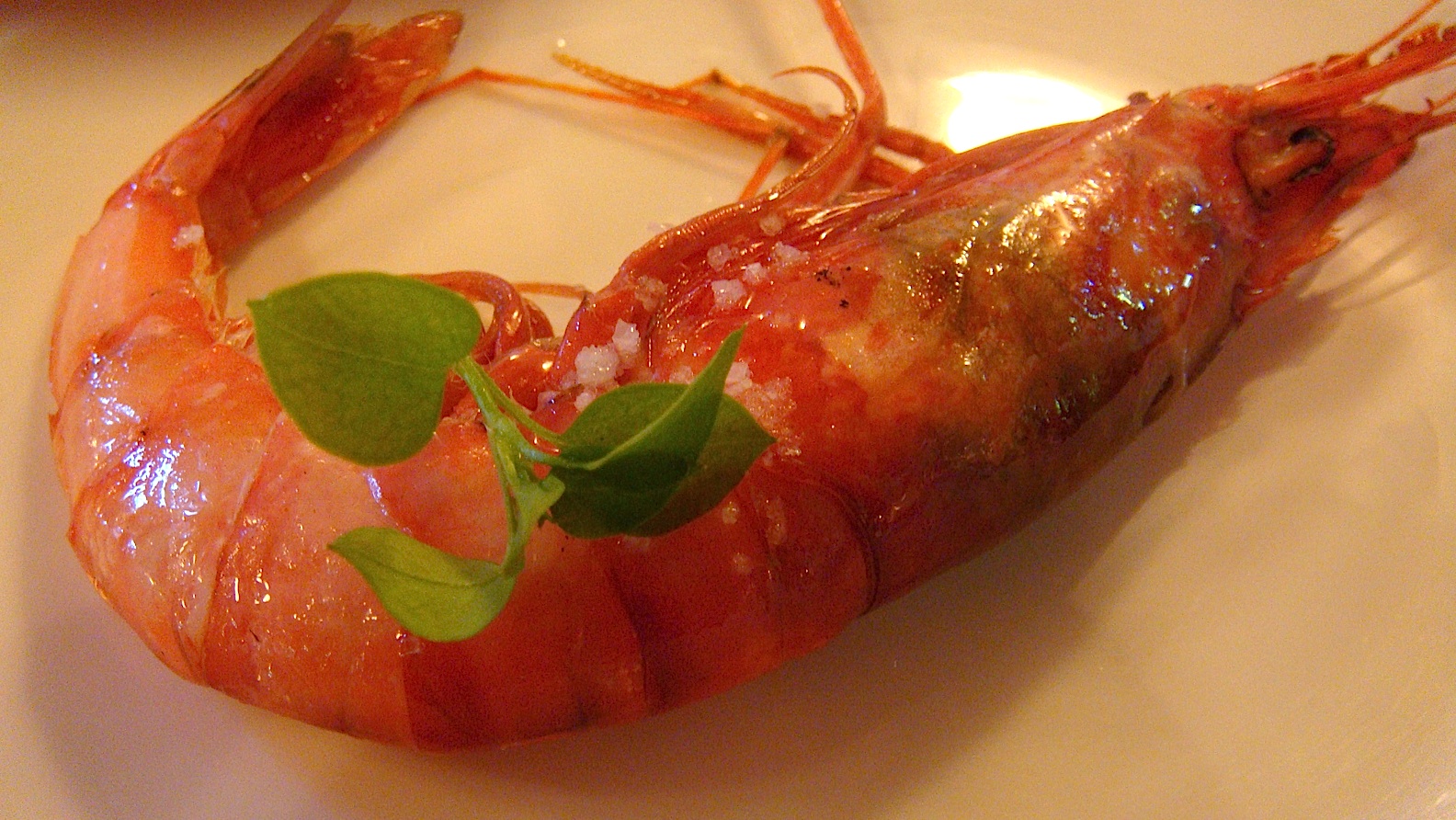 , so
very
lightly grilled, the flesh just warmed through, and drizzled with fine
olive
oil, sea salt, and a little chickweed. Until you’ve had one of these,
you don’t
know what a sweet shrimp tastes like, and to not waste the slightest
bit, we
picked up the heads to make sure we sucked out all the last bits of
flavor. Do
not, I repeat, do not be shy; this is
one of the best parts of the shrimp.
, so
very
lightly grilled, the flesh just warmed through, and drizzled with fine
olive
oil, sea salt, and a little chickweed. Until you’ve had one of these,
you don’t
know what a sweet shrimp tastes like, and to not waste the slightest
bit, we
picked up the heads to make sure we sucked out all the last bits of
flavor. Do
not, I repeat, do not be shy; this is
one of the best parts of the shrimp.
Following the
prawn was another crustacean, a giant specimen, locally called a “Royal
Prawn,”
but universally named the “Slipper Lobster” (below). Once again, it was simply
grilled
till perfectly cooked, tender and succulent, with a natural sweetness
that far
surpassed any Maine lobster I’ve ever had. There is no glitz or
manipulation in these dishes, they are just pure, great ingredients
cooked with a
respect for
what they are.
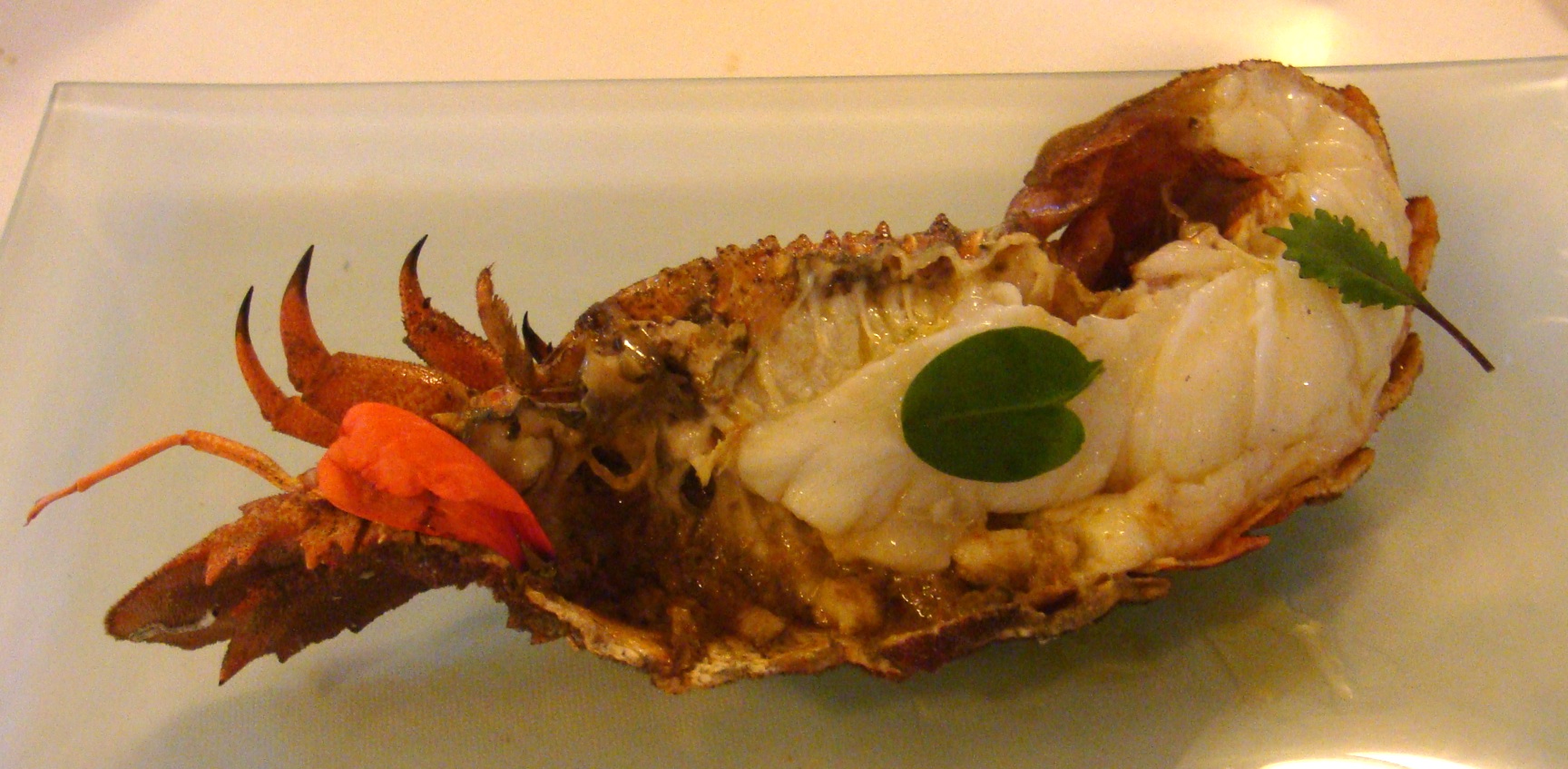 As
we
moved
on,
the
dishes
started
to
become
a
little
bit
more
composed.
First
was
a
dish
of local cockles, grilled till just opened,
with a
light smokiness and finished with grapefruit
segments
and
candied
orange.
Not being a fan of clams in the past, I had to reconsider when I tasted
these. Following
these was baby octopus, pulpito,
quickly grilled and served with a red onion compote, wilted spinach,
pickled
red onion and squid ink sauce. As well as teardrop peas, barely
blanched, with
a just farmed egg yolk, crisps of jamon,
purple
potato
puree,
and
a
garniture
of
pea
flowers,
this
was a dish well thought out but a little too heavy on the
puree,
which overpowered and drowned out
the delicate flavor of the young peas.
As
we
moved
on,
the
dishes
started
to
become
a
little
bit
more
composed.
First
was
a
dish
of local cockles, grilled till just opened,
with a
light smokiness and finished with grapefruit
segments
and
candied
orange.
Not being a fan of clams in the past, I had to reconsider when I tasted
these. Following
these was baby octopus, pulpito,
quickly grilled and served with a red onion compote, wilted spinach,
pickled
red onion and squid ink sauce. As well as teardrop peas, barely
blanched, with
a just farmed egg yolk, crisps of jamon,
purple
potato
puree,
and
a
garniture
of
pea
flowers,
this
was a dish well thought out but a little too heavy on the
puree,
which overpowered and drowned out
the delicate flavor of the young peas.
After
the few composed dishes we had, we went right back to basics, first
with a
whole grilled turbot, in Spain called rodaballo,
served
with an emulsion of its own gelatinous juices,
olive oil and lemon juice. (Turbot is perhaps my favorite fish, and
the hardest to find made well in the States, but if you
want
the best in NYC, look no farther
then Marea, Michael White’s
Italian seafood restaurant on
Central Park South, where he serves it—and I used to cook it when I
worked
there!-- in
almost the same manner.)
And last but not least, was the
steak. Perhaps a
little
background on Spanish meat: 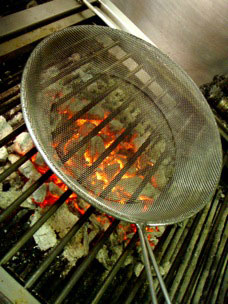 The
Spanish don’t have the same meat or methods of raising cattle as we do
here in
the States. The idea of corn-fed cattle doesn’t cross their minds.
Everything
there is grass fed and aged--but not post-slaughter; instead, they
like
their
cattle older in years than ours, which helps them develop a distinct
flavor
and
tender texture, and to top it off, they serve it rare. Myself, I love
good
American beef, but the Spanish steak is nothing to be balked at,
unique,
flavorful, and extremely tender, and Etxebarri does it well.
The
Spanish don’t have the same meat or methods of raising cattle as we do
here in
the States. The idea of corn-fed cattle doesn’t cross their minds.
Everything
there is grass fed and aged--but not post-slaughter; instead, they
like
their
cattle older in years than ours, which helps them develop a distinct
flavor
and
tender texture, and to top it off, they serve it rare. Myself, I love
good
American beef, but the Spanish steak is nothing to be balked at,
unique,
flavorful, and extremely tender, and Etxebarri does it well.
To
finish our
meal, we had a palate cleanser a floral granita with a hint of anise
liqueur, followed by a smoked fresh cheese
ice
cream with a mixed red berry soup. Remember, I said everything was
smoked over coals, but it’s always done subtly, so as not to
overpower the ingredients. Last was a dessert of milk ice cream
and pain perdu
(grilled and caramelized French toast) with
fire-roasted strawberries.
Etxebarri
was by far one of the most enjoyable dining experiences I’ve ever had,
one filled with wonderful company, calming ambiance, and phenomenal
food. If
you’re in the area, do not hesitate to rent a car, take a cab, or find
some
other way to visit this stand-alone restaurant in the hills of Spain.
You will
be greatly rewarded.
Our
meal, with wine, tax, and service, came to about 165 € per person.
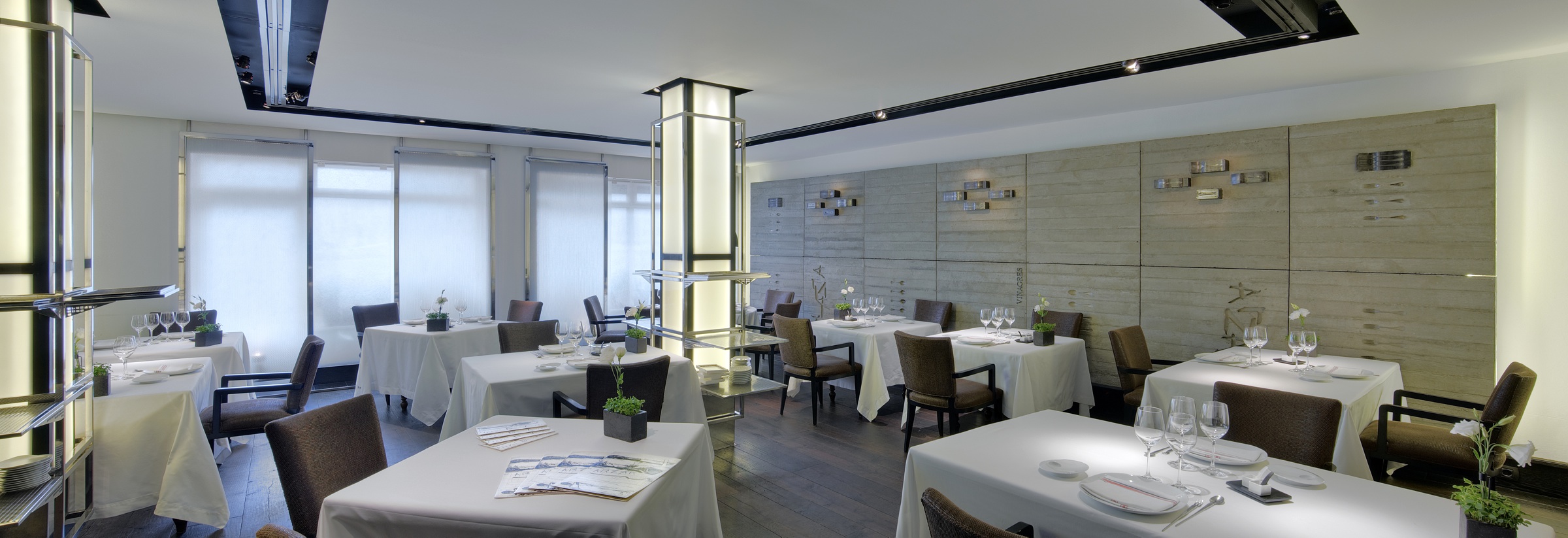 At
the
other
end
of
the
spectrum,
Spain
has
new
restaurants
that dabble in what many have called “molecular
gastronomy,” a genre pioneered by Ferran Adrià at El Bulli
in Roses--who calls his cuisine cocina de vanguardia--and
a far cry from the simplicity and purity of restaurants such as
Etxebarri. Just as in more puritan restaurants, there are good
and bad
specimens, and in a genre of cuisine that sets itself up for a lot of
criticism, risk and potential for shortcomings, there are few places
that
can compete with Arzak.
At
the
other
end
of
the
spectrum,
Spain
has
new
restaurants
that dabble in what many have called “molecular
gastronomy,” a genre pioneered by Ferran Adrià at El Bulli
in Roses--who calls his cuisine cocina de vanguardia--and
a far cry from the simplicity and purity of restaurants such as
Etxebarri. Just as in more puritan restaurants, there are good
and bad
specimens, and in a genre of cuisine that sets itself up for a lot of
criticism, risk and potential for shortcomings, there are few places
that
can compete with Arzak.
Prior
to
walking into Arzak (above), I
had read a lot of different reviews on the
restaurant that
made me believe that I was going to see things I had never seen before,
things
that were going to blow my mind, dishes that I couldn’t recognize. I was expecting it to be a science show,
and when I arrived, yes, there were concoctions I had never seen
before, and, yes, things
that
blew
my
mind,
but
was
it
the
kind
of
lab
experiments
people
make
of
molecular
gastronomy? No. In
the
States,
molecular
cooks’ main
purpose is to wow first, not to satisfy, and
very,
very
few
have
the
experience
and
the
extensive
experimental
background
that
Juan
Mari
Arzak
and
his
daughter Elena (below)
have acquired. They
keep true to their Basque cuisine and respect and
focus on every ingredient, maintaining 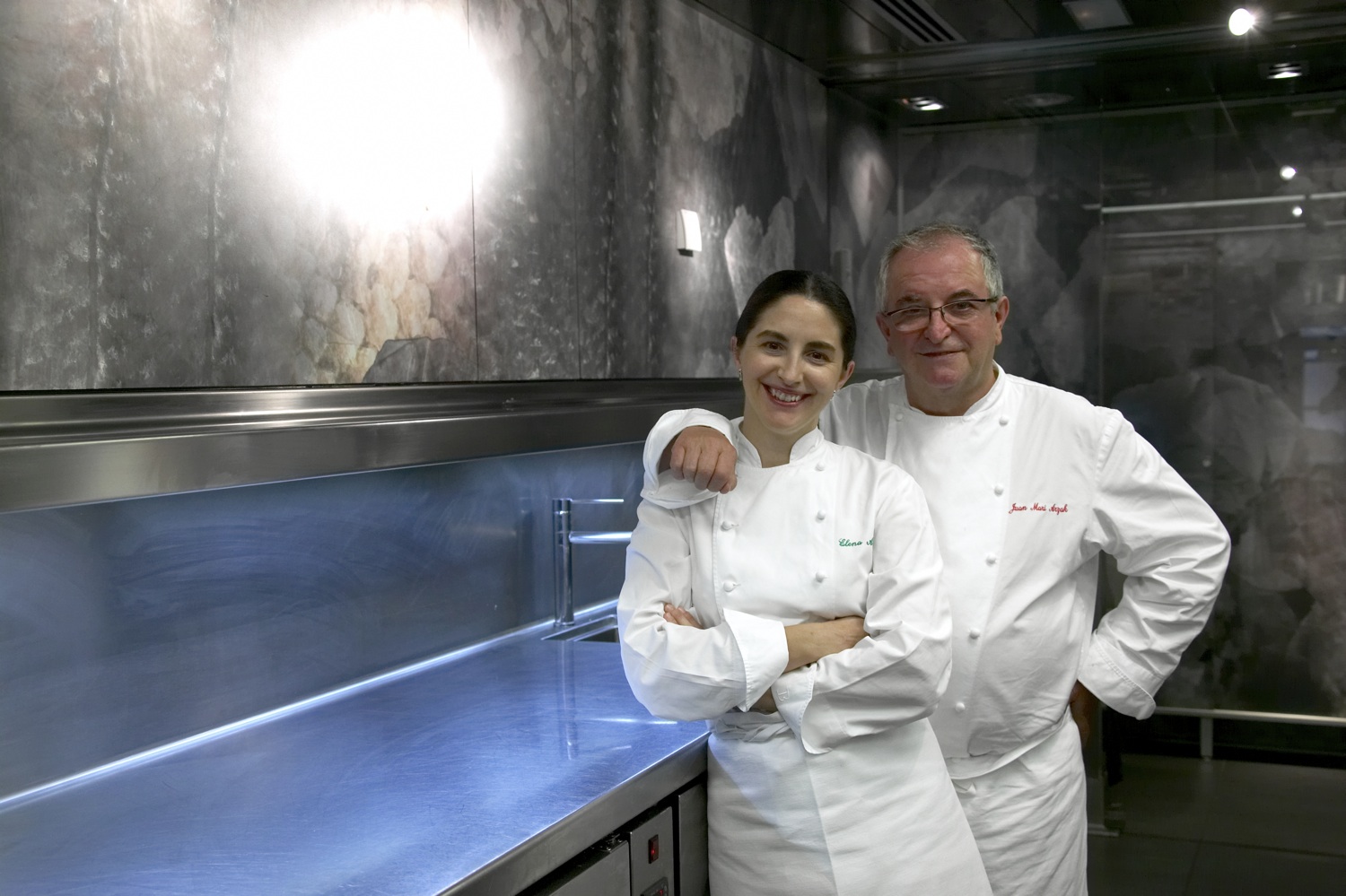 classic cooking techniques highlighted by
some manipulative effects, not the other way around. This, for me, is
what makes
Arzak unique and one of the best at what they do.
classic cooking techniques highlighted by
some manipulative effects, not the other way around. This, for me, is
what makes
Arzak unique and one of the best at what they do.
Arzak
was opened in 1887 by Juan’s grandparents, José Maria Arzak
Etxabe and
Escolástica Lete, with the intention of becoming a distinct
presence in the
city of Alza, which later became San Sebastián. With those
intentions
came
great success. As generations passed, Arzak was transformed into one of
the
innovators and creators of a new, modern, and contemporary cuisine,
changing
the world of gastronomy as people new it, acquiring accolades that
include
three Michelin stars and, in 2009, Spain's
Premio Vedrá.
Juan,
who
had
trained
under
many
of
the
greats
such
as
Bocuse,
Troisgros,
Senderens,
Boyer
and Arrambide,
has now
created his own notch on the totem of
Basque gastronomic history. Elena has degrees from Cambridge and
Oxford,
as well as training with at La
Gavroche, Troisgros, Carrá de
Feuillants, and Vivarois. With these two highly decorated individuals,
you can
imagine what is possible.
To
start off our tasting menu, we began with an array of tasty amuse
bouches, ranging from a simple
bean soup and tart apple, perfectly ripe strawberries with cured
anchovies, and
a tempura of blood sausage, all delicious one- or two-bite morsels to
get the
palate going. Successive dishes
became more 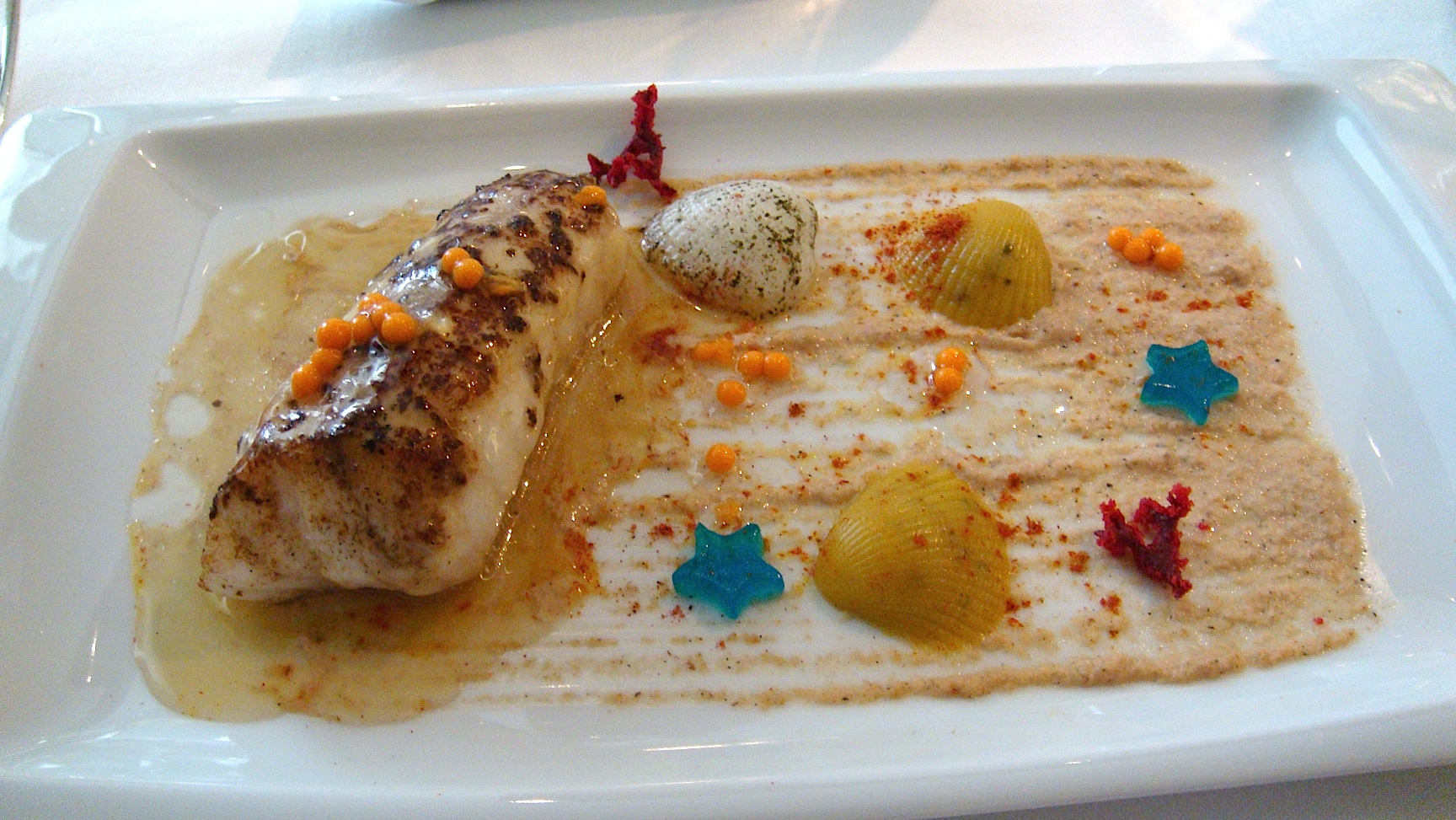 creative and playful, like gently cooked lobster in a boat
of crisp
potato and served with a sauce made from copaiba,
a resin obtained from a legume tree native to South America, followed
by
a poached fresh farm egg “con
temblor de tierra,”
a play on words meaning earthquake, with a crumble of toasted
panko breadcrumbs and
dehydrated mushrooms with a touch of sweetness that balanced out the
whole
dish.
creative and playful, like gently cooked lobster in a boat
of crisp
potato and served with a sauce made from copaiba,
a resin obtained from a legume tree native to South America, followed
by
a poached fresh farm egg “con
temblor de tierra,”
a play on words meaning earthquake, with a crumble of toasted
panko breadcrumbs and
dehydrated mushrooms with a touch of sweetness that balanced out the
whole
dish.
We
then moved
onto our fish course, a dish called Rape
Marea Baja (above),
meaning "low tide," roasted Monkfish and a spread of
almond puree
mimicking sand and clams molded into the shape of a seashell, so that
the dish visually
resembled the seashore scattered with shells, coral and starfish. And
to finish
off our savory courses, ossobuco de
Cordero, a perfectly roasted
loin of lamb served with a natural jus and
garniture of potato transformed into the appearance of a bone.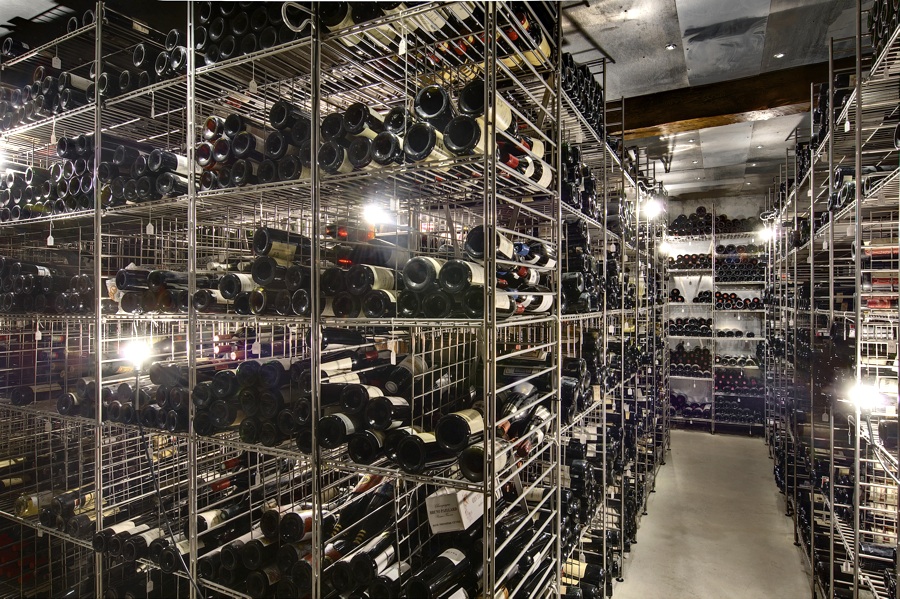
To finish our
meal, we sampled a selection of the desserts ranging from Sopa
y
Chocolate
“entre
viñedos,” a strawberry soup, basil
sorbet,
and molten spheres of chocolate; Bizcocho Esponjoso de Yogurt, a yogurt sponge
cake with a tart of passion
fruit, and white chocolate with a filling of lemon
curd.
Arzak also has
a phenomenal wine cellar (right),
spanning
the
globe
but
with
a
great
focus
on
Spanish
varietals
and
regions.
The list
could take
a half hour to read through, so do not be shy to ask the sommelier for
a
few
recommendations. We enjoyed a 2007 Allende Rioja and 2006 Ceres from
Ribera Del
Duero, which went perfectly with our meal.
An average meal at
Arzak runs about 155 €.
~~~~~~~~~~~~~~~~~~~~~~~~~
NEW YORK
CORNER
by John Mariani
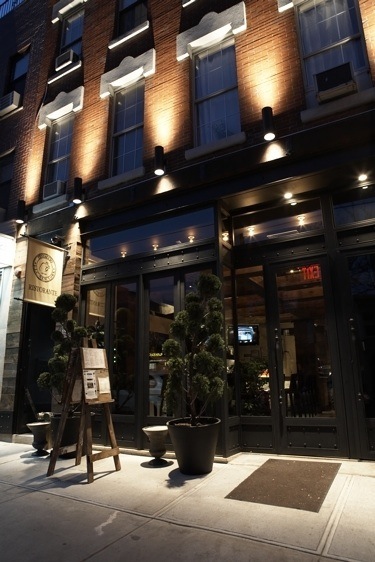 TESTACCIO
TESTACCIO
47-30
Vernon Boulevard
Long
Island City
718-937-2900
www.testacciony.com
It is assumed that you can get anything you want in NYC's Italian restaurants, but in fact, few actually commit to a menu of food from a specific region, instead offering a pan-Italian menu with a few special dishes from Campania or Liguria or Tuscany. So the emergence of Testaccio, named after the eighth hill of Rome, which is really a mound of ancient broken wine amphoras (testae), as the only true Roman trattoria in NYC is absolutely wonderful news.
Owned by Chef-partner
Ivan
Beacco, general manager Adriana Crescenzi, and partners Carlo
and Paul Bordone, seen below with NYC Mayor Mike Bloomberg (a fourth
partner
not in the photo is Alviero Pirani), Testaccio is in Long Island
City, which is not on Long
Island but in Queens, just minutes' drive from the 59th Street,
Triborough, or Whitestone Bridges (the No. 7 subway takes you to Vernon
and Jackson Avenue). It's a long, handsome room with a bar
upfront, ample use of red brick and good lighting, and an open pizza
oven. Beacco will probably bound over to your table to say hello
and make suggestions, but you can pretty much choose from anywhere on
the menu and you'll be amazed at the fidelity of his cooking to Roman
tradition. Only Danny Meyer's new Maialino
in Manhattan comes as close.
The antipasti
include one of the best, crispiest renditions of carciofi alla giudea--fried
baby artichokes--you'll ever taste, and there is a selection of Roman
starters, including
cheeses, salumi, bruschetta
with anchovies, and mozzarella, and scrumptious fried croquettes called suppli with
various
stuffings.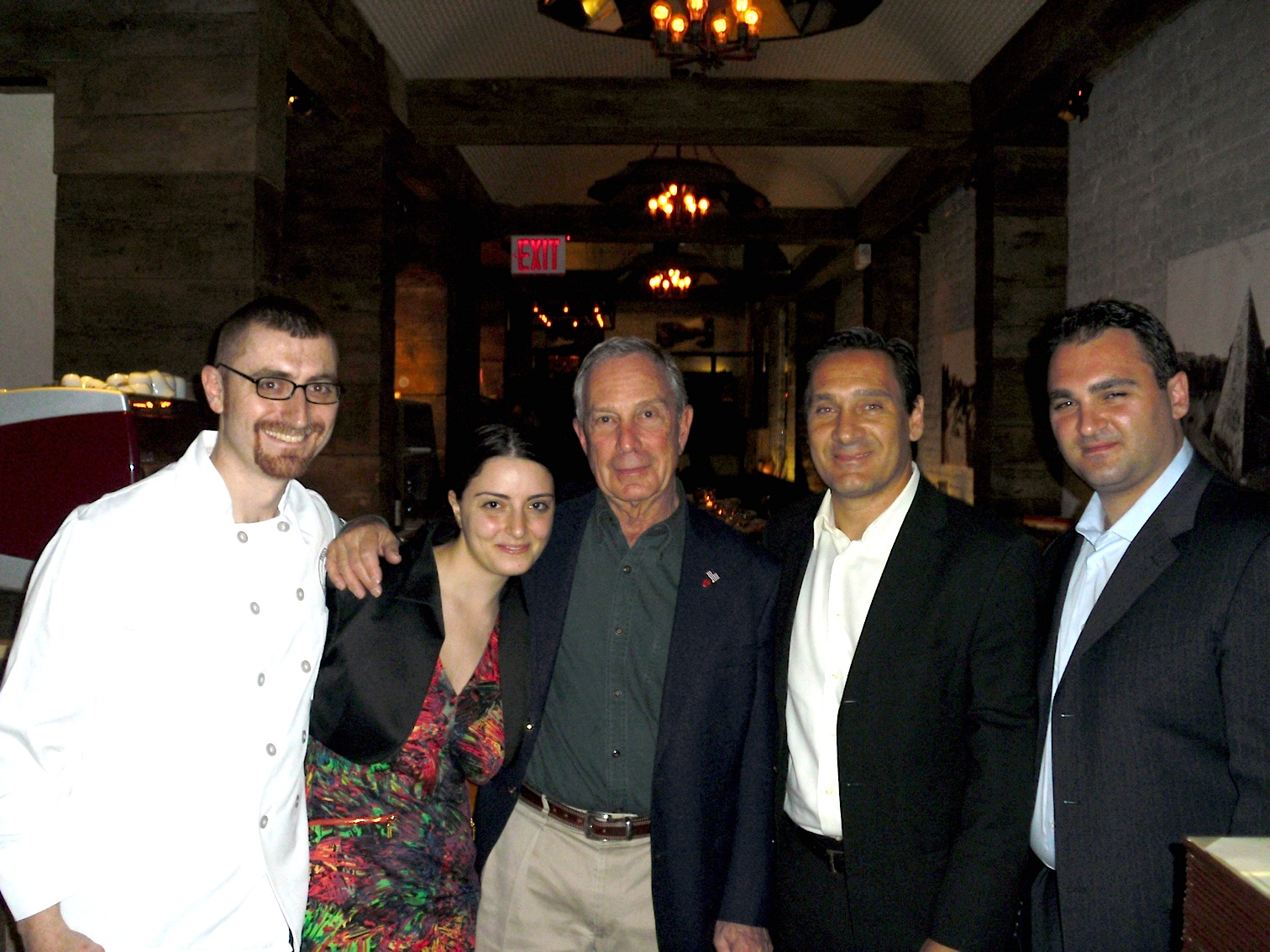
All the pastas I tasted were outstanding, from
the simplest, tagliolini cacio e pepe
(below), graced with nothing
more than cheese and black pepper, to bucatini
all'amatriciana, sweet with tomato, onions, and guanciale; matagliata comes with a rich, heady
ragù and wild mushrooms, and if you love polenta, Testaccio's
will make you blissful--a hefty hill of golden cornmeal with taleggio
cheese and sweet pork sausage--a triumph of good eating. Butternut
squash ravioli in goat's cheese sauce is as good as any pasta in NYC,
or Rome for that matter.
The only disappointment among
the starters was a too-thin pizza, tasty but without the corona of
crust that would make it so much better, despite its being topped with
Gorgonzola, mozzarella, and Italian ham.
As
you
walk
into
the
dining
room
you
may
see
a
whole
suckling
porchetta
to
your right. Order a portion before it's all gone! Its skin cracks
in your mouth, oozes just enough fat, and for $30 it's "all you can
eat," with a side dish and a
glass of Rome's Castelli Romani or
Frascati. If tripe is on your list of hearty offal, by all means
go for the trippa in humido
here, braised a long time with tomato and onions, shaved pecorino, and
the typical Roman addition of mint. Equally 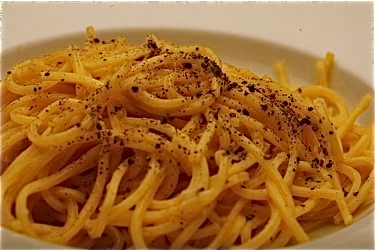 good is the coda alla
vaccinara, braised oxtail in red
wine, with tomato sauce, roasted vegetables and sweet caramelized
onions. For something simpler but every bit as juicy, the roasted
whole Cornish hen comes with vegetables, peppers, and potatoes.
good is the coda alla
vaccinara, braised oxtail in red
wine, with tomato sauce, roasted vegetables and sweet caramelized
onions. For something simpler but every bit as juicy, the roasted
whole Cornish hen comes with vegetables, peppers, and potatoes.
The service staff, which seems
overworked, can also be lax, and you will find yourself hailing a
waiter or busboy throughout the evening. The winelist is just
long and short enough for a trattoria cellar, and there are some very
good buys on it well under $50.
At this point you may wish to stop--and probably
bag some items to take home--but the desserts are worthwhile if nothing
outstanding, the best being the tortino
of chocolate and coffee with caramel sauce.
It is such a real treat to find an authentic
Italian restaurant anywhere, but to find a rigorously true-to-form
Roman restaurant is not just a novelty but an important addition to
NYC's dining landscape. Do not miss an opportunity to dine at
Testaccio if you crave the kind of food you contend you never can get
outside of Rome.
Testaccio is open daily from
noon onward. Antipasti run $8-$15, pastas $14-$19; main courses
$18-$30.
~~~~~~~~~~~~~~~~~~~~~~~~~~~~
NOTES FROM THE WINE
CELLAR
WONDERFUL TWELVE DOLLAR WINES
by
John Mariani
But I am not so
flush these days that I can snub a good bargain, and out of
professional
interest I thought it worthwhile to check out some recent discount
sales at
fine wine stores and see what was worthwhile to drink.
What I found was that, as never before,
much better wines are now being offered at much better prices, owing to
the
huge wine glut on the market during these recessionary times.
As recent
auction prices have shown, the First Growth Bordeaux and the most
illustrious
Burgundies are going for record bids, but below that firmament very
little is
selling well, especially out of French wineries.
France, more
than Italy, Spain, and South America, has not been able to export
enough
interesting, full-flavored wines at moderate prices (under $15) to keep
sales
from flagging, aside from a few enormous successes like Gallo-owned Red
Bicyclette at $8--even after a French court convicted 12 members of the
Languedoc wine industry last February of illegally blending cheap
merlot and
syrah into 18 million bottles of pinot noir-based Red Bicyclette.
So when I
spotted an ad—among many these days—for deep discounts at the fine wine
store Zachys (above) in Scarsdale, NY, that read
“The $12 Sale Is Back!” I thought it worth a
drive to see what’s going cheap these days. I
chose
a
dozen
or
so
bottles
based
on
what
looked
intriguing,
hedging
my
bets
by
siding with Chile, Spain, and Italy, and, after
tasting all
of them, both alone and with summer food, I have to say I was really
delighted
with the majority.
Some of the
wines had been marked down from as high as $23, though most had been
about $17.
At $12 a bottle I would certainly drink the good ones any night of the
week and
happily even pay list price for some. Most
important, my tastings showed that producers are
shipping quality
matched to price in just about every kind of varietal, from barbera
d’alba to shiraz.
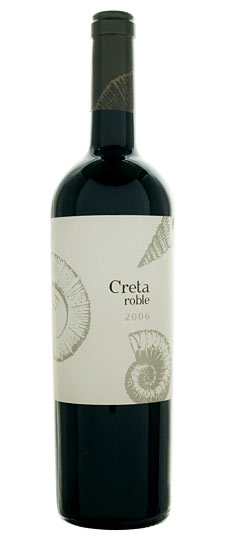 One of the most
impressive was a full-bodied, fleshy Altos
de
Luzon
2006
from Jumilla
in Spain,
a blend of 50 percent monastrell, 25 cabernet sauvignon, and 25
tempranillo of
a kind you usually find in more expensive bottlings. This one showed
bold
tannins and enough spice to go throughout a meal of roast chicken with
white
beans and tangy-hot salsa verde.
One of the most
impressive was a full-bodied, fleshy Altos
de
Luzon
2006
from Jumilla
in Spain,
a blend of 50 percent monastrell, 25 cabernet sauvignon, and 25
tempranillo of
a kind you usually find in more expensive bottlings. This one showed
bold
tannins and enough spice to go throughout a meal of roast chicken with
white
beans and tangy-hot salsa verde.
From Spain’s
Ribera del Duero region came a solidly knit Creta Roble 2006, 100 percent
tempranillo grown at 850 meters (2700 feet), whose coolness calms the
grape and
gives the finished wine a finesse and then a nice bite of acid at the
finish. I drank this with a very
rare porterhouse and nothing but a shake of sea salt and black pepper. Perfect!
A third Spanish
bottling, Borsao Crianza
Selecçion
2006 is another example of how modestly
priced wines need not be one-dimensional. This
is
a
blend
of
50
percent
grenache,
25
tempranillo,
and
25
cabernet
sauvignon,
so
that
the violet notes of the grenache play off the
softness and
tannins of the other two varietals. Curiously
enough,
though
it
began
with
good
backbone,
its
power
faded
after
two
glasses.
A
2008
barbera
d'alba
from
Stefano Farina
in Italy’s Piedmont showed just how good
this workhorse grape can be, even this young, when handled carefully,
revealing
the ripe fruit, the lovely fragrance, and a peppery undertone that
makes it
excellent with red meats like lamb or veal.
Mas du Fadan
Les Fées 2007, from the Côtes du Ventoux in the
southern
Rhône region, had a
characteristic purple color and big rustic smell, which partially
derives from
its not being filtered. It’s a bawdy beauty of a red wine, made for
barbecued
ribs on the grill and sweet corn on the cob.
Not every wine
I tasted was as good as these—a Girard
Sauvignon
Blanc
2009 from Napa Valley
was pale to the eye and palate, and a Lagone
Aia
Vecchia from Tuscany
2007 was
all tannin and no taste. But for a
dozen wines chosen more or less at random, I thought I had found that
level of
quality that puts much more expensive wines into focus when asking the
question, is a $50 bottle really all that much better than a $12 bottle? More and more, I think, the answer is
not quite so easy as it once seemed.
John Mariani's wine column appears in Bloomberg Muse News, from which this story was adapted. Bloomberg News covers Culture from art, books, and theater to wine, travel, and food on a daily basis.
~~~~~~~~~~~~~~~~~~~~~~~~~~

MAN ABOUT TOWN
by
Christopher Mariani
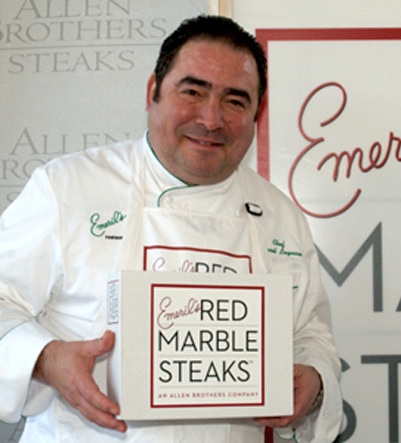 currently being sold online
strictly for US household consumers. Emeril,
who
stands
behind
his
product,
claims
the
Emeril’s
Red
Marble
Steaks
are
the
same
served
at
his
own
Emeril’s Chop
House in PA. At a recent event in Chelsea
NY, showcasing the line’s best cuts of meat, tenderloin, ribeye, and
strip, I was
able to meet Chef Lagasse, who was extremely proud-- rightfully so--of
his
new venture. I tasted the well-fatted 1
1/2 inch- thick juicy ribeye, seared and cooked by the man
himself. According to a spokesperson for
the company, while not all of the steaks are USDA Prime,
all of the steaks sold are hand-selected. With
authentic
NYC
butcher
shops
like
Arthur
Avenue’s
Biancardi’s
slowly
becoming
a
rarity,
it
is
nice
to
see
the
online market offering a new
option
for great steaks, considering we all know of the disappointment when
sifting
through local supermarket chain meat departments filled with
fully
trimmed, extremely lean, tasteless cuts of meat.
currently being sold online
strictly for US household consumers. Emeril,
who
stands
behind
his
product,
claims
the
Emeril’s
Red
Marble
Steaks
are
the
same
served
at
his
own
Emeril’s Chop
House in PA. At a recent event in Chelsea
NY, showcasing the line’s best cuts of meat, tenderloin, ribeye, and
strip, I was
able to meet Chef Lagasse, who was extremely proud-- rightfully so--of
his
new venture. I tasted the well-fatted 1
1/2 inch- thick juicy ribeye, seared and cooked by the man
himself. According to a spokesperson for
the company, while not all of the steaks are USDA Prime,
all of the steaks sold are hand-selected. With
authentic
NYC
butcher
shops
like
Arthur
Avenue’s
Biancardi’s
slowly
becoming
a
rarity,
it
is
nice
to
see
the
online market offering a new
option
for great steaks, considering we all know of the disappointment when
sifting
through local supermarket chain meat departments filled with
fully
trimmed, extremely lean, tasteless cuts of meat.The Plaza Food Hall by Todd
English--On
June
4,
Chef
Todd
English
opened
The Plaza Food Hall, inside NYC's
Plaza Hotel on Fifth Avenue at Central Park South,
offering New Yorkers and visitors both prepared and retail food items. The hall, seating up to 80, is made up
of eight unique food stations including the ocean grill and oyster
bar, which sells whole fish, fresh oysters,  Alaskan king crab and even prepared
items like lobster rolls and grilled
Alaskan king crab and even prepared
items like lobster rolls and grilled 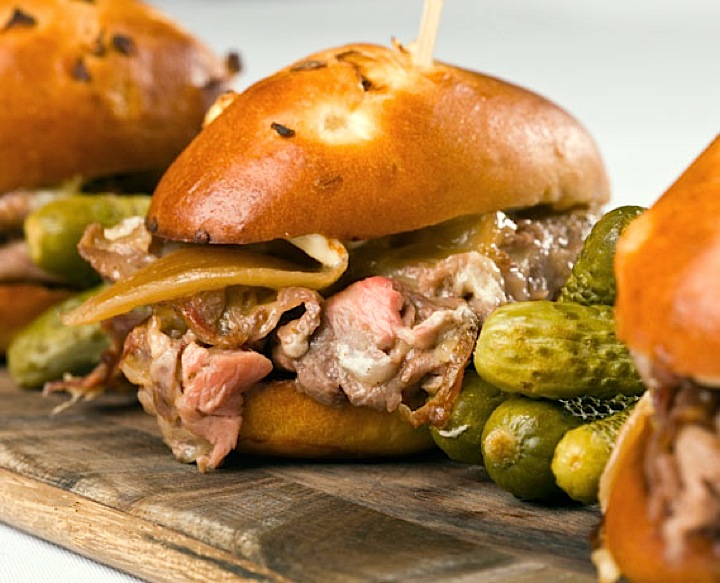 branzino to be brought home. The
grill, prepares amazing made-to-order burgers--my favorite is the
prime rib
slider topped with
caramelized onions and fontina cheese--and also savory
carved meat sandwiches, one filled with warm apple wood smoked turkey
breast
placed on fresh Sullivan Street Bakery ciabatta bread. I recommend no one leave the Food Hall
without stopping
by the alluring pizza station, which
serves thin crust pizzas topped with interesting European ingredient
combinations like fig jam, prosciutto, gorgonzola and rosemary; another
tasty
pie is topped with spicy chicken sausage, roasted tomato sauce,
balsamic sweet
onions, and ricotta cheese. The
dumpling bar has an Asian menu with
items like shrimp stir fry with udon noodles, prawns, ginger, chopped
cashews,
scallions and a touch of orange. The Food
Hall also has delightful items found at the other
four
stations: Cheese and Charcuterie, Salads
and sides, Sushi, and Tapas.
English and executive chef Mike Suppa have obviously
researched and
picked the best
ingredients for the Food Hall and have covered quite an extensive range
of food
for one single location.
branzino to be brought home. The
grill, prepares amazing made-to-order burgers--my favorite is the
prime rib
slider topped with
caramelized onions and fontina cheese--and also savory
carved meat sandwiches, one filled with warm apple wood smoked turkey
breast
placed on fresh Sullivan Street Bakery ciabatta bread. I recommend no one leave the Food Hall
without stopping
by the alluring pizza station, which
serves thin crust pizzas topped with interesting European ingredient
combinations like fig jam, prosciutto, gorgonzola and rosemary; another
tasty
pie is topped with spicy chicken sausage, roasted tomato sauce,
balsamic sweet
onions, and ricotta cheese. The
dumpling bar has an Asian menu with
items like shrimp stir fry with udon noodles, prawns, ginger, chopped
cashews,
scallions and a touch of orange. The Food
Hall also has delightful items found at the other
four
stations: Cheese and Charcuterie, Salads
and sides, Sushi, and Tapas.
English and executive chef Mike Suppa have obviously
researched and
picked the best
ingredients for the Food Hall and have covered quite an extensive range
of food
for one single location.
AND
MR.
PEANUT
WANTS
TO
SPEAK
WITH
HIM,
TOO
The Pittsburgh Pirates fired Andrew Kurtz, one of the people
who race
around the field in pierogi costumes, because he criticized the
contract extensions given to
general manager Neal Huntington and manager John Russell
on his Facebook page. The minor league Washington Wild Things thereupon offered
Kurtz
a job as one
of its racing hot dogs.

UNLIKE
THAT SOURPUSS HOMOSEXUAL DEMOGRAPHIC THAT JUST WANTS TO EAT CHEAP AND
GRUMBLE
"Context is everything.
Tacolicious, the new Marina bar and taco place that took over Laiola
after a
three-year run, is a huge hit. Though the tapas at Laiola were
extraordinary,
the check for them mounted fast, and the young, heterosexual Marina
demographic
didn’t seem to care all that much for esoteric Spanish food and wine.
They
wanted fun."--
Patricia
Unterman, "Food: From tasty tapas to heaping tacos on Chestnut
Street," The Examiner
(June 25,
2010).
~~~~~~~~~~~~~~~~~~~~~~~~
QUICK BYTES
✉ Guidelines for submissions: QUICK BYTES publishes only events, special dinners, etc, open to the public, not restaurant openings or personnel changes. When submitting please send the most pertinent info, incl. tel # and site, in one short paragraph as simple e-mail text, WITH DATE LISTED FIRST in format below, as below. Thanks. John Mariani
* For month of July, Mélisse, in Santa Monica, CA offers its 11th anniversary 4-course menu by Chef Owner Josiah Citrin. $65 pp. Call 310-395-0881. . . . On July 26 Mélisse presents Guest Chef April Bloomfield of The Spotted Pig (NYC), a special menu at $65 pp with a portion of proceeds to benefit Special Olympics, Visit http://www.melisse.com or call (310) 395-0881.
* On July 17, in San Francisco join EPIC Roasthouse for its 2nd annual Pinot tasting and pig roast event, "High on the Hog." $95 pp.VIP tix $160 incl. a private reception and demo with Chef Jan Birnbaum on how to make his signature barbeque sauce. Call 415-369-9955; http://www.epicroasthousesf.com
* From July
19-25, in Washington D.C.,
Urbana
Restaurant and Wine Bar will celebrate its fourth birthday with
Chef
Alex Bollinger to serve a four-course $40 menu incl.
Prosecco, birthday cake, and glass of wine with dinner. Call
202-956-6650.
* On
July 20 in New Orleans, LA,
the
Southern
Food and Beverage Museum will host Virginia Willis and Lisa
Ekus-Saffer for a Cookbook Publishing 101 class. $199 pp. Call
504-569-0405 or
visit www.southernfood.org
.
. . . On July 25 the Museum will begin a "Dinner and
Movie" series, showing
food films by the Southern Foodways Alliance and offering a special
discount to
Zea's Grill on St. Charles. $10 pp for non-members. . . . On August 8
the Museum will hold its 3rd annual
fundraiser, "Eat!
Drink! SoFAB! Tailgating party." Local chefs will prepare sophisticated
riffs on
tailgating foods and local athletes are invited. Gal Holiday and the
Honky Tonk
Revue will play. $75 pp.
* On July 20,
in NYC, Henry’s
hosts Transportation Alternatives Summer Benefit dinner by Chef Mark
Barrett. $200
pp.
Visit www.transalt.org.
.
.
.
On
July 22,
Henry’s host its 2nd
behind-the-scenes tour of the local 116th Street Greenmarket followed
by a
seasonally-inspired lunch menu by Chef Barrett. Proceeds to the
Greenmarket’s Youth Education Program. $45 pp. . . . On Aug 2, Henry’s
will
hold “Sing for Your Supper,” a night of song on Broadway,
with soprano
Amy Burton and pianist/composer John Musto, paired with Chef Barrett’s
3-course,Spaghetti & Meatballs dinner for $19. All Italian-American
varietal
wines half-price. . . . On Aug 19,
Henry’s launches its guest chef dinner
series
with "Hot Summer Nights -- A Taste of Brazil." Chef Barrett welcomes
Chef Leticia Moreinos Schwartz, author of The
Brazilian Kitchen, for a traditional Brazilian meal and
music. $65 pp. Call
212- 866-0600 or visit http://www.henrysnyc.com.
* On July 24
in Oakville, CA, Music in the Vineyards presents
"Roll Over Beethoven" from Napa Valley’s Star Vintners, incl. Bill
Phelps, Violet
Grgich, David Duncan and Jeff Gargiulo . $175 pp. Call 707-258-5559.
* On July 26 in NYC, A Voce Madison presents a 4-course dinner with speaker Maurizio DeRosa of Feudi di San Gregorio. Chef Missy Robbins’ menu will be paired with exceptional selections from this progressive winery. 1$40 pp. Call 212-545-8555.
* On July 30 in Chicago, IL, Fleming's Prime Steakhouse & Wine Bar features Grgich Hills Estate Wines with a special 5-course wine dinner. $90 pp. Call 312-329-9463.
* On July 30, Jean-Louis in Greenwich CT will host Margareth Hendriquez, new president of KRUG Champagne, who will present the Krug collection. $195 pp 5 course dinner by Jean-Louis Gerin. Call 203-622-8450.
* On July 31 in Oakland, CA, the East Bay Vintner's Alliance will host its 5th annual "Urban Wine Xperience." Nineteen urban wineries will pour a variety of sparklings, whites, roses and reds alongside 19 local restaurant and food purveyors. $45 in advance, $60 at the door. Visit http://www.eastbayvintners.com/events.html#uwx5.
* From July
31-Aug. 1 in Atlantic City, Harrah’s Entertainment Atlantic City
will host the "Food Network Atlantic City
Food and Wine Festival" at Harrah’s Resort, Caesars, Showboat &
Bally’s.
Chefs incl. Guy Fieri, Sandra Lee, Ted Allen, and Pat & Gina
Neely. Tix start at $30 and may be purchased at
www.acfoodandwine.com or call 800-745-3000.
*
On
July
31,
Mimosa Grill, in Charlotte, NC, will
host a 5-course dinner featuring the wines of Domaine Serene
Vineyards by
Executive Chef Jon Fortes. $75 pp. Call 704-343-0700; http://www.mimosagrill.com
.
* From Jul. 31 – Aug. 30 in Worcestershire, England, the Pershore Plum Festival, celebrates locally sourced plums and related recipes including main courses, desserts, jams and preserves, sauces, chutneys, pickles as well as juices and wines, ending on England’s August Bank Holiday. Tix prices vary based on event. Call 44-0138-656-5373.
*From Aug. 1 – Sept. 30, in Miami, FL, the
Miami Spice Restaurant program returns for its 9th consecutive year
featuring
top fine dining restaurants offering 3-course menus at $22 pp. for
lunch; $35 pp. for dinner. For more info visit
http://www.ilovemiamispice.com.
*
From Aug. 3 – 7 in London, England,
the
Great British Beer Festival, Britain’s biggest
beer festival ,will
showcase international brands as well as small, local brewers of real
ales,
ciders and perries at London’s Earls Court. The Champion Beer of
Britain
competition will also be judged. Tickets in advance are £6
for
CAMRA members and £8 for non-members or £8 for CAMRA
members and £10 for
non-members at the door. Call 44-0844-412-4640.
*
On
August
2
in
Beachwood, OH, Moxie the Restaurant
Executive Chef
Jonathan Bennett partners with NYC’s Sip Sak owner Orhan Yegen in the
preparation of a 5-course Turkish
dinner. $99 pp plus tax and gratuity. Call 216-831-5599.
* From Aug. 4
– Oct. 31, in South Beach, FL,
The Setai’s The
Restaurant will feature “Flavors of India," every
Wednesday
night.
Every
two
months,
a
renowned
Indian
Chef
will
host
the
dinner
to
present an authentic 4-course menu.
Three choices will be offered per course and the menu will conclude
with a
glass of homemade Chai Tea and Petit Fours. $60 pp. Visit http://www.setai.com
. . . . From Aug. 5 – Oct. 31, The
Setai’s The Bar &
Courtyard is will feature perfect for a Jazz Night under the
stars. Specials on Taittinger Champagne by the glass
and bottle.
~~~~~~~~~~~~~~~~~~~~~
Everett Potter's Travel Report:

~~~~~~~~~~~~~~~~~~~~~~~~~~~~~~~~~~~~~~~~~~~~~~~~~~~~~~~~~~~~~~~~~~~~~~~~~~
Eating Las Vegas is the new on-line site for Virtual Gourmet contributor John A. Curtas., who since 1995 has been commenting on the Las Vegas food scene and reviewing restaurants for Nevada Public Radio. He is also the restaurant critic for KLAS TV, Channel 8 in Las Vegas, and his past reviews can be accessed at KNPR.org. Click on the logo below to go directly to his site.
~~~~~~~~~~~~~~~~~~~~~~~~~~~~~~~~~~~~~~~~~~~~~~~~~~~~~~~~~~~~~~~~~~~~~~~~~~~
Tennis Resorts Online: A Critical Guide to the World's Best Tennis Resorts and Tennis Camps, published by ROGER COX, who has spent more than two decades writing about tennis travel, including a 17-year stretch for Tennis magazine. He has also written for Arthur Frommer's Budget Travel, New York Magazine, Travel & Leisure, Esquire, Money, USTA Magazine, Men's Journal, and The Robb Report. He has authored two books-The World's Best Tennis Vacations (Stephen Greene Press/Viking Penguin, 1990) and The Best Places to Stay in the Rockies (Houghton Mifflin, 1992 & 1994), and the Melbourne (Australia) chapter to the Wall Street Journal Business Guide to Cities of the Pacific Rim (Fodor's Travel Guides, 1991). THIS WEEK:

Family Travel
Forum: The
Family
Travel
Forum
(FTF),
whose
motto
is
"Have
Kids,
Still
Travel!",
is
dedicated
to
the
ideals,
promotion
and
support
of
travel
with
children.
Founded
by
business
professionals John Manton and Kyle
McCarthy with first class travel industry credentials and global family
travel experience, the independent, family-supported FTF will provide
its members with honest, unbiased information, informed advice and
practical tips; all designed to make traveling a rewarding, healthy,
safe, better value and hassle-free experience for adults and children
who journey together. Membership in FTF will lead you to new worlds of
adventure, fun and learning. Join the movement.
All You Need to Know Before You Go
nickonwine: An engaging, interactive wine column by Nick Passmore, Artisanal Editor, Four Seasons Magazine; Wine Columnist, BusinessWeek.com; nick@nickonwine.com; www.nickonwine.com.

MARIANI'S VIRTUAL GOURMET NEWSLETTER is published weekly. Editor/Publisher: John Mariani.
Contributing Writers: Christopher
Mariani, Robert Mariani,
John A. Curtas, Edward Brivio, Mort
Hochstein, Suzanne Wright, and Brian Freedman. Contributing
Photographers: Galina Stepanoff-Dargery, Bobby Pirillo. Technical
Advisor:
Gerry McLoughlin.
Any of John Mariani's books below
may be ordered from amazon.com by clicking on the cover image.
 My
newest book, written with my brother Robert Mariani, is a memoir of our
years growing up in the My
newest book, written with my brother Robert Mariani, is a memoir of our
years growing up in the For those of you who don't think of the Robert and I think you'll enjoy this very personal look at our --John Mariani |
 |
 |
 |
 |
 |
 |
© copyright John Mariani 2010
